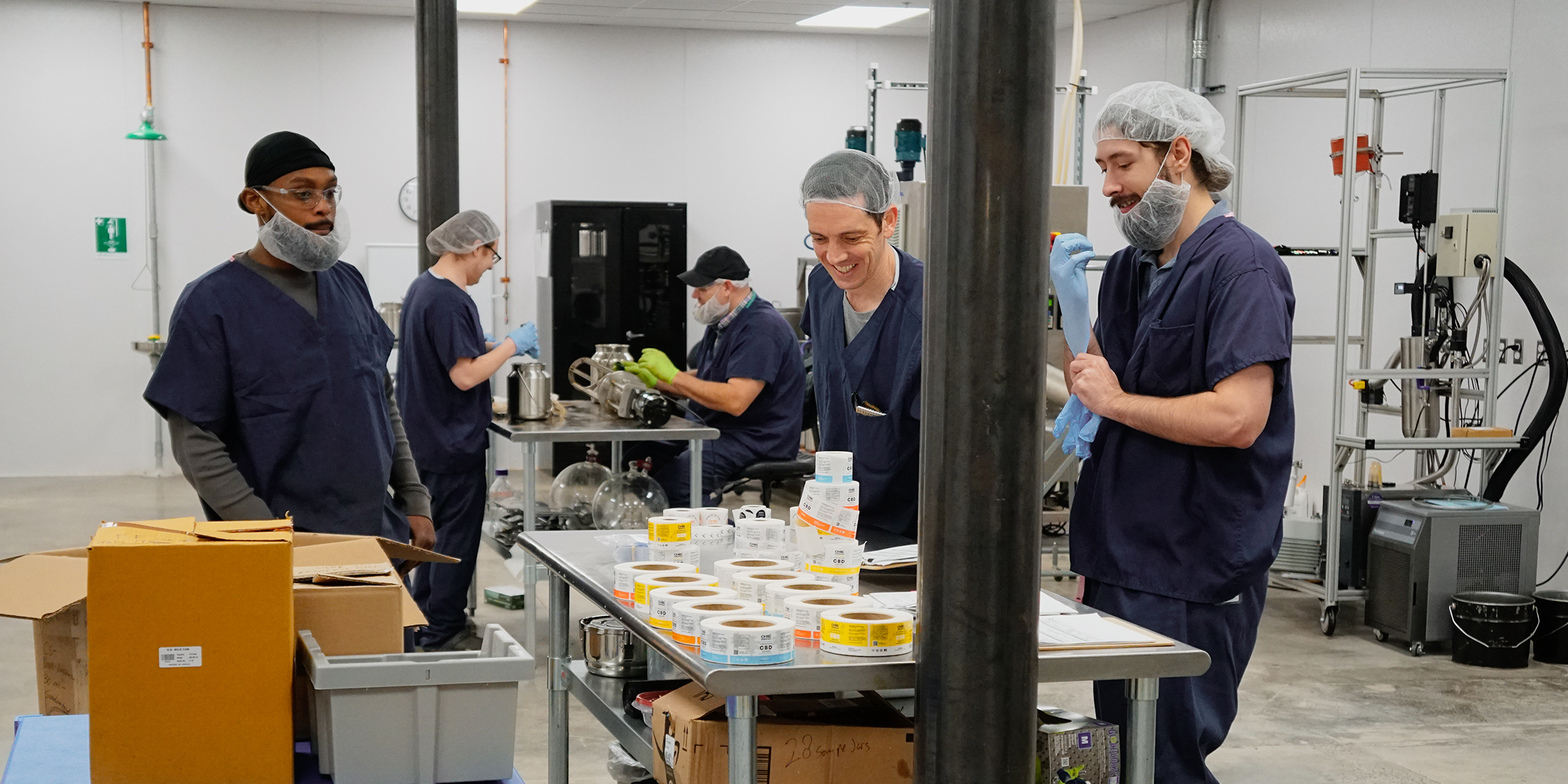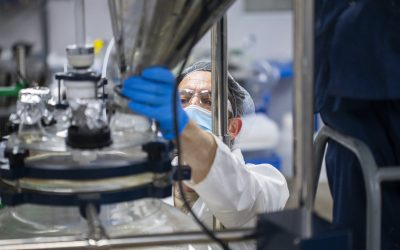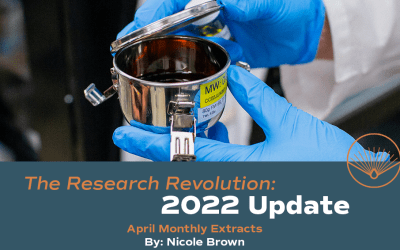Author: Dave Neundorfer
Dec 1, 2020 – 5 min read
Last month, I shared with you a guide to quality control in CBD 3.0, where we discussed the technological advancements and testing methods necessary to ensure the integrity and consistency of your supply chain and the quality and purity of your products.
These are two legs of the stool that will support the robust, cross-category, adoption of cannabinoid products that enhance quality of life and wellbeing globally. The third leg of the stool is research. Research is not only critical to confirming the safety and efficacy of the underlying compounds and formulations, it will also inform regulatory policy, accelerate innovation, and, most importantly, provide the data needed to educate the mainstream consumer and catalyze broadscale adoption.
This market’s need for research is acute and urgent, far too large of a challenge and opportunity for a single company to realize using the traditional model of “closed innovation.” This moment requires “open innovation”, an enlightened model which leverages tech-enabled global interconnectedness to democratize information, accelerate intercompany collaboration, and optimize R&D by leveraging best practices across multiple philosophically aligned organizations. As Harvard Business School Professor Henry W. Chesbrough correctly asserts, the “closed” paradigm is obsolete; the new “open innovation” model is needed to strategically leverage “internal and external sources of ideas” to go to “market through multiple paths”.
OBX is built for open innovation, combining the internal R&D lab and capabilities and sales and marketing channels needed for commercialization with a team that is humble enough to realize that we cannot expect all of the best ideas to come from within our company. We ask questions, identify areas of alignment, and quickly and creatively structure win-win partnership models with other labs, researchers, and, at times, competitors. This philosophy has made OBX an IP magnet, as evidenced by the numerous partnerships we have announced this year, including Prinova, a global ingredient distributor, Lygos, a specialty ingredient producer, and Volunteer Botanicals, which takes cannabinoids to flowable powders leveraging a proprietary lipid neutralization system.
Today, we are excited to share that we are delving deeper into the research needed to understand the mechanistic impact of cannabinoids on the brain. We have kicked off a collaborative research project with a soon-to-be announced university collaborator. OBX will provide their lab with pure cannabinoid extracts, including CBD, CBG, CBN, CBC, THCV, and CBDV isolates and custom formulations, and our university partner will analyze the impact of these isolated and precise ratios of cannabinoids will have on brain cell function, with a focus on neuroinflammation.
As minor cannabinoids continue to grow in popularity with promising commercial and therapeutic benefits, we look forward to contributing to the rising tide of research that will provide the foundation needed for mainstream adoption, including the preliminary studies conducted by Biomedican and efforts from labs around the globe focused on unlocking the potential of THCV.
Of course, THCV is just one of the many breakthrough opportunities in this nascent market’s future. The work that lies ahead of us is daunting and exhilarating. If you are a researcher, a professor, a chemist, or a cannabinoid company advancing our understanding of cannabinoid-enabled health and wellness, I want to first thank you for your work to advance this once-in-a-lifetime research opportunity. I also want to invite you to join us in leveraging the open innovation model that is needed to overcome the substantial challenges–a rapidly evolving market, uncertain regulations, and a consumer base that is hungry for research-backed products–that we currently face.
Author: Dave Neundorfer
September 30, 2020 – 5 min read
Over the past few months, we’ve shared our perspective on what the cannabinoid industry needs to graduate from a nascent, $1B industry into the mainstream, cross-category, $20B+ powerhouse that analysts have heralded since the passing of the 2018 farm bill. This shift is happening now, driven by research, innovation, and a flight to quality by forward-thinking brands and the CPG “buyers of tomorrow.”
At OBX, most of our research and innovation has been focused on minor cannabinoid production and formulation and downstream technological advancements that make those ingredients and formulations more effective and palatable to the mainstream consumer.
Minor Cannabinoid Production and Formulation: We’ve blogged about the therapeutic potential of CBN, CBDV, THCV, & CBC, which are already playing a critical role in delivering function-specific formulations that the market demands. Working with minor cannabinoids demands production, testing, and product development rigor and precision, an all-hands on deck pursuit between partners like LYGOS, our in-house ops and quality assurance teams, and our 3rd-party control laboratory.
Technological Advancements: We’ve partnered with other high-integrity organizations like Prinova and Volunteer Botanicals to fuel our ingredient innovation pipeline for our current clients and the buyers of tomorrow. Prinova is our nano-emulsification partner that can convert any of our cannabinoids into water soluble powder or liquid, whereas Volunteer Botanical can convert cannabinoids into a standardized, flowable powder that can be used for precisely dosed dissolvable tabs or capsules. Both of these innovation partners help streamline the adoption of cannabinoids into the routines of mainstream consumers.
As we attract leading CBD and CPG brands as clients, we are undergoing multiple “new supplier audits” per week and are experiencing the market’s “flight to quality” first-hand in the form of supply chain validation, quality management system assessments, and internal and external testing standards and protocols evaluations. These audits are demanding and thorough, which gives our team confidence that this market evolution will result in higher quality, consistent, effective products for the end consumer.
Ensuring the integrity of our ingredients is a primary pillar in the OBX portfolio. With so many new products entering the fold, we’ve worked hard to establish standards to verify that every ingredient we offer to clients or that act as inputs into our finished goods is one of the purest inputs on the market.
While we have posted, blogged, and press released our minor cannabinoid capabilities and technology partners, I’d like to use this edition of Monthly Extracts to talk about the quality management foundation that makes this all possible.
Verifying the integrity of your supply:
Governing bodies around the world require consumer products to be tested before they reach consumers. As a GMP-certified processor with international distribution reach, our quality management system enables and validates the safety, quality and consistency of input ingredients, a critical step towards ensuring that all finished formulations and products abide by the governing law across markets with different regulatory requirements.
At OBX, robust testing is conducted at every step of the production process. Our QC Manager, David Temelkoff, a seasoned research scientist who spent 15 years at industry-leading pharmaceutical company GlaxoSmithKline, designed and implemented a rigorous set of internal testing standards for our work-in-progress and finished products to verify the chemical and physical makeup of each compound and apply a baseline safety analysis test. This robust quality control program touches all aspects of our ingredient sourcing, production, and finished product formulations. It also serves as the foundation for every international quality assurance and compliance standard demanded by both domestic and international clients.
To ensure the replicability and reproducibility of results, our industry-leading internal testing protocols need to be validated by external labs. So, David also works with our certified 3rd party lab partners to develop and validate their testing methods to ensure that the appropriate standards, methods, and tolerances are in place and aligned. Once our products receive our internal stamp of quality approval, we then seek third-party validation in the form of a certificate of analysis (COA). COAs are the table stakes required to sell cannabinoid products as they are a holistic assessment of the underlying product that ensures that regulatory and safety requirements are met. For every product, OBX provides a 3rd-party, full panel Certificate of Analysis that includes:
- Potency (HPLC): THC is a cannabinoid that leads to psychoactive effects. Hence, it is crucial to test the potency of the cannabinoids present in your sample to meet regulatory compliance. In particular, THC levels higher than 0.3% are prohibited. In addition, potency checks are essential to provide an in-depth overview of the ingredients in your product to validate the purity and quality of the ingredient you are purchasing.
- Terpene Profiling: Terpenes are a group of organic molecules that contain an aromatic functional group. These molecules are produced naturally in trichomes of the cannabis plant. They give rise to the distinct colours and smells such as pine, berry and fruity citrus aromas. Although these molecules are not harmful, profiling can be necessary when you are evaluating the composition of your product before purchasing.
- Pesticides: Given that farmers regularly grow plants, they will also use pesticide sprays to maximise crop yield and strengthen pest control. However, pesticides, such as DDT, have also been shown to bioaccumulate within food chains. If this was not controlled, pesticides can also have mutagenic effects and harm consumers.
- Heavy Metals: Industrial plants and textiles can lead to unwanted metals within cultivated soil. Moreover, the bioaccumulation of heavy metals amongst any food chain can be toxic. Therefore, it is essential to minimise human contact with such contaminants whenever possible, as exposure to unwantedly high levels of metals can lead to cancer and fertility issues.
- Residual Solvents: Residual solvents include organic solvents that can be present in large quantities when CBD is concentrated from the cannabis plant. It is essential that these solvents, such as benzene and toluene, are removed.
- Organic Toxins: Hemp can contain low levels of moisture. If not adequately stored, fungal growth can be promoted, and the subsequent production of harmful mycotoxins can occur. Also, microbe growth can be promoted by the accumulation of persistent organic pollutants and plastics, so it is also essential to check for these too.
At OBX, we often go above and beyond the COA assessment depending on the product type and client demands. We have the internal lab and team capabilities to complete supplementary analyses, which may include:
- Mass Spectroscopy: This analytical technique involves the identity testing of a sample. In essence, a mass spectrometer will undergo a series of steps to identify the components in a sample. This includes vaporisation, ionisation, acceleration, deflection, and detection. There are many different types of mass spectrometry instruments. However, they each achieve the same goal. After the initial vaporisation of the sample, it is bombarded with high energy electrons which lead to its respective ionisation. The ions are then accelerated in an electric field and deflected by a magnetic field to reach the detector. The detector will then provide a graphical chart of peaks against the mass of the ions that it detects.
- Thermogravimetric Balance: This technique will assess the amount of moisture in a sample which could eventually lead to fungal growth, whereby the sample is slowly dried over time, and any changes in mass are recorded. In essence, no change in weight suggests that no water is present (no water evaporating off the sample). Thus, there will be no required concern for microbes.
- High-Performance Liquid Chromatography (HPLC): This chromatographic technique can separate different molecules, such as cannabinoids, by exploiting the different polarities that these molecules possess. In essence, this chromatographic technique works by utilising a stationary phase (polar silica beads) and a mobile aspect (a non-polar organic solvent). Every molecule will have a certain level of polarity, and this will determine the extent to which they are attracted to either phase. HPLC will measure the retention time (i.e. how long it takes for the molecule to pass through the instrument). The retention time is unique for every molecule with a given stationary and mobile phase. HPLC can be thus used for identity testing and plays a fundamental role in identifying THC and other cannabinoids.
- Gas Chromatography (GC): This technique is similar to HPLC in that the retention time of the sample is recorded. However, the sample is vaporised and pushed along by a carrier gas (mobile phase nitrogen gas) over the stationary phase (usually a solid). Inductively coupled plasma mass spectrometry (ICP-MS) This type of testing looks for heavy metals in a sample. A sample is placed in an argon aerosol, and the material splits and ionises. These ions are then carried towards a mass spectrometer, where they are detected according to their mass-to-charge ratio.
- Polymerase Chain Reaction (PCR): PCR is used to identify and quantify the number of microbes that could be present in a sample. In retrospect, PCR entails a series of steps that involves extracting the microbe’s DNA. The final amplified DNA is then separated by gel electrophoresis, which allows each microbe DNA to be identified. In this case, the amount of each microbe is proportional to the fluorescence of each sample.
- NMR Analysis: Nuclear Magnetic Resonance (NMR) spectroscopy is an analytical chemistry technique used in quality control and research for determining the content and purity of a sample as well as its molecular structure. For example, NMR can quantitatively analyze mixtures containing known compounds. For unknown compounds, NMR can either be used to match against spectral libraries or to infer the basic structure directly. Once the basic structure is known, NMR can be used to determine molecular conformation in solution as well as studying physical properties at the molecular level such as conformational exchange, phase changes, solubility, and diffusion.
- LC-MS and/or GCMS: Both LC-MS and GC-MS are methods to separate chemicals in a mixture or a sample. Both methods separate the chemicals by chromatography first, then further examine and identify them by the mass spectrometer. Additionally, both methods require a mobile phase and a stationary phase. The only difference is that LC-MS uses a solvent as its mobile phase, while GC-MS uses inert gases (like helium) in the same capacity.
- Any additional analyses related to the presence of, identification of, and quantitation of impurities
As this industry continues to catapult into the mainstream, OBX is doing it’s part to ensure that the ingredient and finished product supply chain has the robust quality management systems and testing protocol that one would expect of any other CPG or nutraceutical product.
As we continue to attract and partner with like-minded technology partners to serve forward-thinking brands, we are completing a value chain that will ensure consumers have the best possible experience with their cannabinoid-based products.
As we continue to fight for regulatory clarity in our own domestic market, we are self-regulating in hopes of giving the FDA a model of quality management and GMP-certified operation that can be standardized across the industry to ensure marketwide maturation and professionalism.




